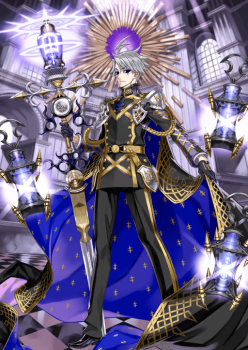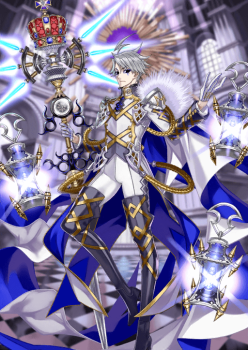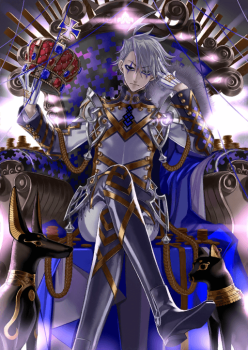Like Ryouma before him, Moriarty’s refund is such that he’s dependent on either CEs or plug in order to loop. His NP gain is unfortunately not where it would need to be to tri-loop with just Castoria and the 2004 Mystic Code, although the right event CE can make up the difference, especially with Mana Loading further increasing his flexibility. Against Casters, at least, he can loop standard nodes plugless, though he has to use a mystic code buff on one turn and his first skill on another. On turn 1, Mana Loading, his own battery, and two Castorias’ 20% batteries bring him to 100% charge for his first NP. With Moriarty’s Arts resist down buff on one turn and another buff (such as 2004’s NP gain buff) on another turn, Moriarty refunds 70% per turn and reaches 100% with a Castoria Charisma on turns 2 and 3. It’s not the best setup, and it doesn’t work against all classes, but it’s there.
With plug, though, things look a little better for Moriarty. His loop conditions are nearly identical to Ryouma’s, in that with Mana Loading, two Castorias, and Oberon, Moriarty can loop any node with at least four enemies in the first two waves. On turn 1, Moriarty gets both Castorias’ charismas and Arts buffs, and one Castoria’s NP gain buff, taking him to 100% charge. Moriarty also uses his own Arts buff. You use Moriarty’s battery on turn 2 and Oberon’s 50% battery on turn 3, plus the remaining two 20% batteries (Castoria’s and Oberon’s) to make up for each “missing” enemy. In 3/1/x nodes, Moriarty will also need either an extra hit of overkill or his first skill’s Arts resistance debuff to refund the necessary 50% on the first wave, but it’s still doable.
Additionally, while Moriarty can’t farm 2/1/x or 1/2/x nodes on his own, he has a 50% battery and can work well paired with an ST DPS (such as Hephaestion) for those nodes. He can even use his first skill to push the ST DPS’s damage if need be (though this comes at the cost of his own damage, which is often at a premium in those sorts of nodes).
For CQs, Moriarty can blitz with your usual optimized Arts strategies. That is to say, double Castoria and whatever other supports you want to run. While Moriarty’s individual Arts cards are bad, he does have three of them, which mitigates RNG if you’re relying on cards to loop. There are lots of ways to set Moriarty up if you’re running conventional Arts blitz, so feel free to experiment with what you have until you find a setup that works for you. Do note, though, that ideally Moriarty wants to be fighting Good enemies for his supereffective bonus, and if he is, that means he’s not hitting Evil, which then means Moriarty has to wait until turn 2 to use his first skill to maximize his damage. Whether this is the optimal play or not will depend on how much health the first set of break bars has; if Moriarty needs the extra damage from the jump, he has to sacrifice later-turn damage-potential, but if he doesn’t need the extra damage on turn 1, he can hold onto the skill for more damage on turns 2 and 3.
As an Arts Servant, Moriarty can stall effectively with Castoria as well. Reines/Moriarty/Castoria is the best setup for this, as Reines boosts Castoria’s (and Moriarty’s) overcharge levels while also providing charge, damage buffs, and NP gain buffs. Tamamo is also an option, providing healing, Arts buffs, and NP damage buffs in exchange for contributing less to hard survival. Himiko/Moriarty/Castoria is an interesting team as well; it’s a little less stable than the equivalent Reines team, but in exchange it gives slightly more safety with each Castoria NP than the Reines team does, and—more importantly—Himiko provides attack and crit buffs to the whole party, making Moriarty’s crit turns more impressive and letting the whole team hit harder (in exchange for weaker NPs from Moriarty).
Speaking of Himiko, if you want a flavorful team, you can run a triple-Ruler setup: Himiko/Moriarty/Sherlock is an interesting team where all three Servants can force crits, and Himiko and Sherlock both provide teamwide crit damage buffs. With a Himiko->Sherlock->Moriarty NP chain, you get 125% teamwide crit damage up for the next three turns, ensuring whoever draws cards can deal solid damage, while also getting nice damage out of Moriarty’s own NP. Also, since you’re running a team full of Rulers, all of whom have selfish defense tools, the team is surprisingly bulky. Is this optimal? Definitely not. Will it work well enough for lower-difficult fights? Probably.
For more conventional lower-end play, though, Moriarty has enough basic in-kit tools that he can function decently with less-powerful supports. Lanling in particular is a good pick, as Lanling augments Moriarty’s crit damage and lets Moriarty leverage his decent hit counts to generate stars. Hans is a solid option for similar reasons: he provides stars and charge while also boosting Moriarty’s crit damage.
As a final note, Moriarty’s ability to apply Evil makes him a surprisingly good support for Astraea specifically. Much like George for Kriemhild, Moriarty’s trait debuff gives Astraea an extra 50%+ on her NP that stacks multiplicatively with everything. He also gives 20-40% Arts resist down, solidifying him as probably the best offensive buffer Astraea can get. Beni is also an Arts Servant with anti-Evil damage, but hers is Power Mod rather than Supereffective Damage, so it doesn’t stack as nicely as in Astraea’s case.
The Black Grail is, as always, the best CE for raw damage output. In stall contexts, though, or if you need to push Moriarty’s NP refund a bit more, you could also consider something like Formal Craft or Sign of Smiling Face. Starting NP gauge CEs are also an option, as they make it much easier for him to loop.
Crit damage up CCs are generally nice on Moriarty, as he has a way to rig easy crits, but he doesn’t have a ton of in-kit crit damage up. Aside from that, there’s not a lot Moriarty needs that CCs can help with. NP damage up CCs (on his Buster, for instance) can help offset his low base damage, if you remember to put the card you choose before his NP.

 4
4 4
4 4
4 5
5 4
4






































